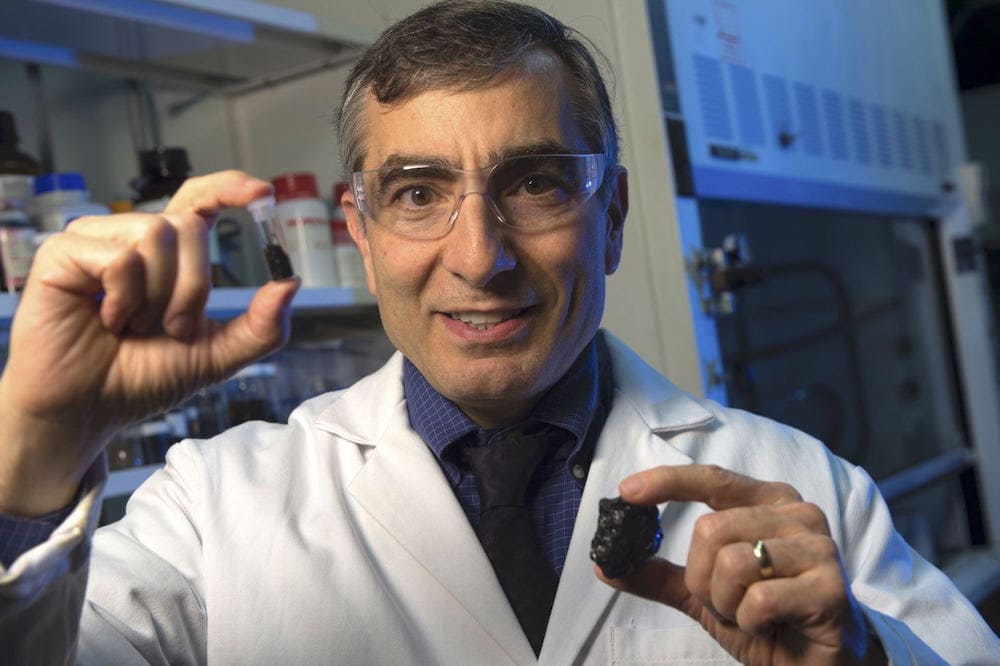
[Image] Rice University chemist James Tour holds coal and a vial of coal-derived graphene quantum dots. The dots have been modified for use as an effective antioxidant. Credit: Jeff Fitlow, Rice University
Coal used for power generation presents some pretty damning statistics. It accounted for about 67.9 percent of carbon dioxide emissions in the United States electricity sector even though it only generated 31.2 percent of electricity in 2017. Air pollution from burning coal contributes to respiratory, cardiovascular, and neurological health effects, among others.
Despite promises by political entities to save coal, saving coal as an energy source appears unlikely. Coal power projects are declining in the U.S. and around the world as renewables gain traction (renewables even surpassed coal in U.S. electricity generation for the first time this April).
But power generation is not the only application of coal.
Many up-and-coming advanced materials rely on one thing: carbon. Carbon fibers for structural applications and additive manufacturing; graphene for various electronics, from computers to solar panels. However, the transition of these high-performance materials into everyday life have been somewhat limited by cost—the cost of producing carbon.

Though about 95 percent of coal produced worldwide is used for power generation, coal can also be a cheap source of carbon for advanced materials. Credit: Pixabay
As explained in an American Coal Council article, many of these advanced materials get their carbon from petroleum, which increases the cost of production significantly. But carbon could instead be sourced considerably cheaper from coal. “Although petroleum and coal have about the same percentage of carbon (about 75 percent), a ton of petroleum is about $500. A ton of coal from the Powder River Basin costs less than $15.”
Currently, only about 5 percent of all coal produced worldwide is used to make higher-value products (the other 95 percent is simply burned). If mining companies began selling their coal to universities, laboratories, and manufacturers who study and produce carbon-based advanced materials, it could be a win-win for both materials science research and the coal industry.
One Rice University professor definitely sees the benefit of sourcing carbon for his research from coal.
James Tour, Rice University professor of chemistry, computer science, materials science, and nanoengineering, studies graphene quantum dots (GQDs), microscopic discs of atom-thick graphene oxide that could be used in medical imaging as well as sensing, electronic, and photovoltaic applications. In 2013, he and his colleagues found a way to reduce three kinds of coal into GQDs, a finding they published in Nature Communications.
“Fluorescent quantum dots are extremely expensive and they’re toxic very often,” Tour explains in a Rice University video. “But these [coal-derived dots] are nontoxic and they fluoresce.”

Graphene quantum dots derived from coal fluoresce and are much cheaper and nontoxic compared to other fluorescent quantum dots available on the market. Credit: Rice University, YouTube
Tour and colleagues published another paper in 2014 that showed the efficacy of these coal-derived GQDs as a fuel cell catalyst. This year, they showed another application for the material—as an effective antioxidant to treat people who suffer traumatic brain injuries, strokes, or heart attacks.
Antioxidants are substances that prevent or slow damage to cells caused by free radicals (unstable molecules made by oxidation during normal metabolism). When someone is injured, rapid production of reactive oxygen species (a free radical) can overwhelm natural antioxidants. This situation has led researchers to investigate if a quick injection of reactive nanomaterials could limit the collateral damage caused by free radicals.
In 2015, Tour and colleagues from Baylor College of Medicine and University of Texas Houston Medical School showed hydrophilic clusters modified with polyethylene glycol (PEG) are effective antioxidants. However, their latest study, including colleagues from Texas A&M Health Science Center, shows the coal-derived GQDs improve on these earlier efforts.
“Replacing our earlier nanoparticles with coal-derived quantum dots makes it much simpler and less expensive to produce these potentially therapeutic materials,” Tour says in a Rice University press release. “It opens the door to more readily accessible therapies.”
The researchers tested GQDs extracted from both bituminous and anthracite coal and found that smaller 3–5 nm bituminous dots were more effective than larger 10–20 nm anthracite dots. “Although they both work in cells, in vivo, the smaller ones are more effective. The larger ones likely have trouble accessing the brain as well,” Tour says.

Coal-derived graphene quantum dots as seen under an electron microscope. The researchers found smaller bituminous dots were more effective than larger anthracite dots. Credit: Tour Group, Rice University
For all the division between miners and environmentalists over using coal as an energy source, it is easy to forget that coal is simply a hunk of carbon. How we use coal determines its environmental impact and, as Tour’s research shows, it can actually encourage positive health effects in applications other than power generation!
The paper, published in ACS Applied Materials & Interfaces, is “Highly oxidized graphene quantum dots from coal as efficient antioxidants” (DOI: 10.1021/acsami.9b01082).
Author
Lisa McDonald
CTT Categories
- Environment
- Nanomaterials


